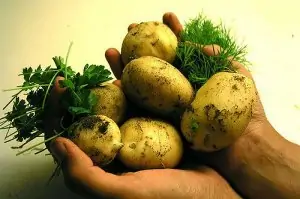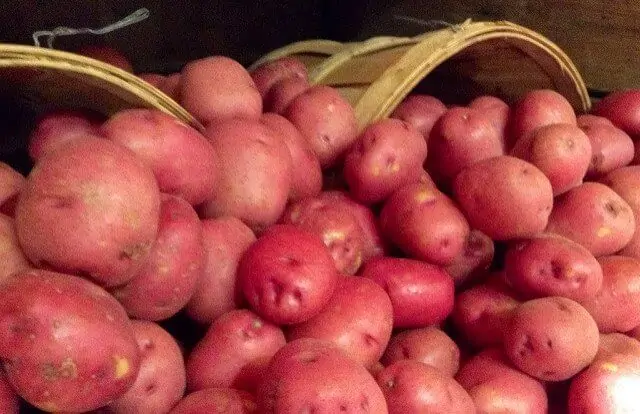
Potatoes come in all shapes and forms. But if you just bought a big batch of spuds and don’t want to end up throwing half of them out, you have to know how to store them properly. Potatoes are prone to rotting. But if you know the right conditions to store them under, you can keep your potatoes fresh for months after you buy them.
Best potato types for storage
When you buy your batch of potatoes, there are some factors to consider if you want them to last as long as possible. Yellow and white skin varieties usually keep better than red-skinned potatoes because the red skin varieties generally have thinner skin. Some of the longest lasting varieties include Russet, Yukon Gold, Kennebec, and Yellow Finn.
Eating potatoes is more fun than storing them. Check out this potato cookbook from Amazon.
Curing
If you grew your own potatoes, you’ll want to cure them before storing them. Cure thickens the skin of the potatoes, allowing them to self-preserve longer. You can start curing potatoes weeks before they even come out of the ground by reducing how much water they get.
Once you dig up the potatoes, spread them out on a sheet of newspaper or blanket. Keep them in a well-ventilated, dark area, with a temperature of about 70-75 degrees Fahrenheit. Leave them undisturbed in these conditions for about 10 days until the skin is tangibly thicker and dry.
Get better at storing everything. Here’s how to keep lettuce longer.
Preparation
After you’ve either cured or bought your potatoes, it’s time to clean them. Although it seems counter-intuitive, be sure not to use any water when cleaning them. The added moisture can cause them to rot. Instead of the typical soap and water method, just brush off any dirt or soil with dry hands.
The last step in the preparation phase of your potato storage project is to inspect the spuds for any signs of deterioration. This includes soft spots, mold, damage, pests, or sprouts. Some of these (like sprouted potatoes) can be used within a day or two for cooking if the sprouts or other problem areas are removed.
Once you have your clean, spotless, cured potatoes ready, it’s time for storage.

Storage containers
Anyone of the following are the best materials to use for storing your potatoes long term.
- Crates (Yes you can buy these at Amazon)
- Cardboard boxes
- Paper Bags
- Burlap Sacks (Guess Amazon sells literally everything)
- Mesh Bags
All of these materials are well-ventilated. Air circulation is a major factor to consider when storing your potatoes, as a well-circulated environment can prevent rotting. Avoid plastic bags or containers, since plastic inhibits air ventilation and can shorten the potatoes’ shelf life by months.
This potato masher from Amazon is pretty great for mashed potatoes. And these hand mixers are even better.
Temperature
After packaging your potato batch, you’ll want to keep them in a cool, dark area for best results. Cool and bright areas can cause the potatoes to green or rot.
Temperatures should be about 45 to 50 degrees Fahrenheit, and the environment should be slightly humid since overly dry conditions can dehydrate the vegetables. Unheated garages or basements may be the best areas of your house to store potatoes.
Be sure not to make the mistake of storing your raw potatoes in the refrigerator, since the cold temperatures will cause the starch in the potatoes to turn into sugar.
Conditions
There are a few other storage conditions to keep in mind when packing up your potatoes. Make sure to keep them away from other produce, especially onions, since they can cause the potatoes to ripe much faster than you would want. The potatoes actually have the same effect on the onions, so you’ll create a negative effect on both vegetables.
Ready to try making potato gnocchi? I’ll show you the best ricer for the job.
Check
Every few weeks, you should check on your potatoes to make sure they’re staying in top shape. Get rid of any in the batch that develops spots or rotting. Throw away and replace any paper or other material touching the rotten spots as well so that it doesn’t spread to other potatoes.
Greening potatoes should also be thrown away unless it’s a small spot that can be cut off. In this case, cook that potato soon, since the potato can’t be stored once the skin is broken and the inside is exposed.
What to do with that potato? Rice it (Amazon)!
Also, if you find any that have sprouted during storage, you don’t have to throw them out, but you should remove them from the rest of the batch and use for cooking within 2 days, making sure to cut the sprouts off before cooking them.
Conclusion
Stored properly with the right materials and conditions, your potatoes should last about 4 to 6 months, and up to 8 if cured.
What’s next?
I’ll show you the best way to fry chicken wings.





Alexis DeAnda is a food fanatic, library card user, and cast iron hunter, in that order. She has been cooking for anyone that will taste it ever since her mom let her make doughnuts on Saturday mornings at the age of 7.